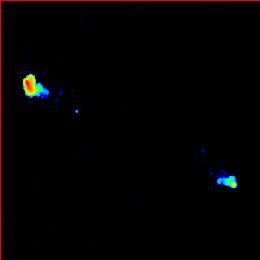 Image:
Image:3C 299 | B1419+419 |
| S178 | Alpha | FR | Class | ID | Spectrum | Best z | mag. | LAS | lg P178 | D |
|---|---|---|---|---|---|---|---|---|---|---|
| 12.9 | 0.65 | II | CD | Gal | 0.367 | R(c) = 18.51 | 11.90 | 26.44 | 48.8 |
| Size: | 13.2 × 13.2 arcsec² |
|---|---|
| LUT: | Logarithmic |
| Beam: | 0.15 arcsec |
| Frequency: | 1534 MHz |
| Method: | CLEAN Õ˜ÿ>0.15
|
| Telescope: | MERLIN |
| Credits: | Leahy (1997) |
3C 299 is the most asymmetric classical DRAGN in the Atlas sample, in terms of both lobe length and lobe flux. The reason for this is apparent from the optical emission-line image of McCarthy, Spinrad & van Breugel (1995): the eastern jet has run into a high-density cloud which is visible through strong line emission. The filamentary structure of this obstructing cloud is clearly visible in the HST R-band image of de Koff et al. (1996). (Most of the emission in the hotspot region of their image is probably from H-beta+[OIII], which are redshifted into their passband for 3C 299).
In the HST image, the host galaxy proper is double-peaked, either due to a dust lane across the nucleus or because this is a double galaxy. Accurate optical astrometry would locate these peaks relative to the nucleus as defined by the radio core, and so resolve this ambiguity.
3C 299 is also the most hotspot-dominated object in our sample, with both lobes containing well over 50 % of their flux density in very compact structure. It is particularly interesting that this is true for the faint southwestern lobe (whose partial bridge is so faint that it is only visible on our C20 image), since it is unaffected by the cloud collision. It may be significant that the second-most hotspot-dominated object in our sample, 3C 321 is also highly asymmetric in total flux density (but not in lobe length).
Because of the large asymmetry and poor astrometry,
the bright eastern hotspot of 3C 299 was originally
believed to be a compact steep-spectrum source (CSS), coincident with the
host galaxy. Many images of this DRAGN therefore only show the hotspot,
which has sometimes been mistaken for a jet pointing towards the south.
The western hotspot was discovered by
Laing (1981a), but the true nature of
3C 299 did not become clear until the discovery of the central component
by Liu & Pooley (1991b) and
van Breugel et al. (1992).
| Prev. | Data Page | Other images | Next | Search | Alphanumeric List | Icon List | Atlas Index |
|---|